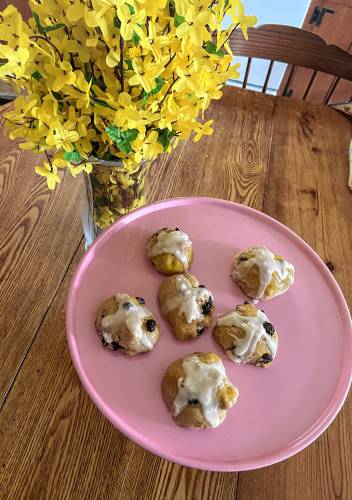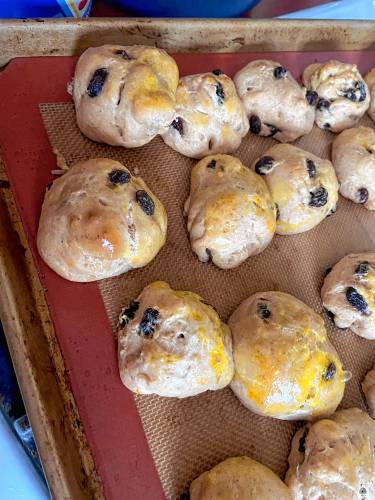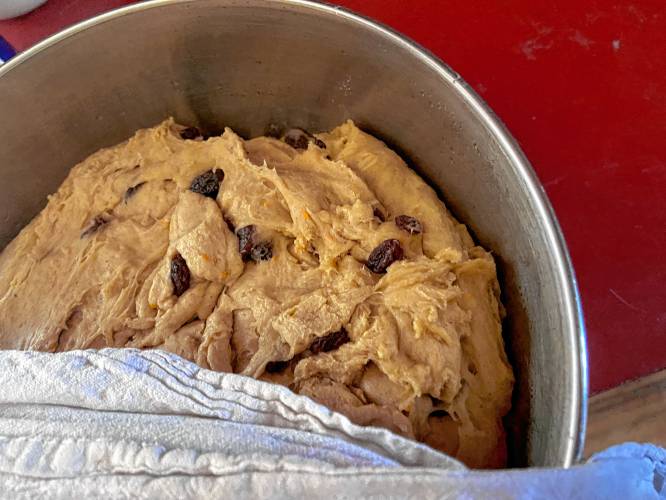‘No bunnies in the Bible’: Unpacking the myths and history of hot cross buns at Easter
| Published: 03-26-2024 3:55 PM |
When I was a child, I loved embracing spring at this time of year by eating a hot cross bun. I still do.
Hot cross buns are sweet, yeasty rolls traditionally served toward the end of Lent, specifically on Good Friday. The cross of icing that tops them symbolizes the crucifixion. The spices that flavor the buns represent the spices used in wrapping the body of Jesus for burial.
Like many Christian traditions and foods, the buns were probably adapted from pagan practice. They supposedly honored Eostre, a Saxon goddess of fertility, whose name inspired not only Easter but estrogen. She, not the New Testament, was also the probable root of the association of Easter with eggs and bunnies.
As journalist Karen Cyson wrote a couple of years ago, “There is no fecund rabbit toting a basket of dyed eggs in any variation of the Easter story. There were no jelly beans at the Last Supper. There are no bunnies in the Bible.”
Originally, the cross on top of the buns represented either the four quarters of the moon or the perfect balance of the sun at the vernal equinox, which fell this year on March 19.
Despite their pagan origins, the buns — like many religious rites and symbols — were happily adopted by Christians.
A monk named Thomas Rockcliffe is said to have begun distributing the buns to the poor in St. Albans in England in 1361 as part of a missionary effort. They became a popular treat throughout the country.
When Elizabeth I was queen (her father Henry VIII had banned the Catholic church for reasons of his own), she outlawed the consumption of the buns except during religious festivals.
Article continues after...
Yesterday's Most Read Articles
 Police report details grisly crime scene in Greenfield
Police report details grisly crime scene in Greenfield
 Authorities ID victim in Greenfield slaying
Authorities ID victim in Greenfield slaying
 State records show Northfield EMS chief’s paramedic license suspended over failure to transport infant
State records show Northfield EMS chief’s paramedic license suspended over failure to transport infant
 New buyer of Bernardston’s Windmill Motel looks to resell it, attorney says
New buyer of Bernardston’s Windmill Motel looks to resell it, attorney says
 On The Ridge with Joe Judd: What time should you turkey hunt?
On The Ridge with Joe Judd: What time should you turkey hunt?
 Ethics Commission raps former Leyden police chief, captain for conflict of interest violations
Ethics Commission raps former Leyden police chief, captain for conflict of interest violations
Vendors on the streets of London are said to have hawked them enthusiastically at Lent, giving rise to the nursery rhyme: Hot cross buns, hot cross buns, / One a penny, two a penny, hot cross buns. / If ye have no daughters, give them to your sons. / One a penny, two a penny, hot cross buns.
According to a 2014 Smithsonian magazine article, several legends have sprung up around hot cross buns. One is that, perhaps because of the spices or perhaps from some Easter magic, a bun hung from the ceiling at Easter will stay fresh (and grow no mold) for an entire year.
Moreover, the cross on the suspended bun will protect the kitchen from evil spirits, prevent kitchen fires, and ensure that bread baked all year tastes good.
Another legend is that people who share a hot cross bun will enjoy a close friendship throughout the year. I’m skeptical about the buns’ claims to eternal freshness — I have never met any sort of bread that didn’t mold over time — but I find this legend quite believable. Sharing food is, after all, a sure-fire way of sharing love. Consequently, I made hot cross buns for friends this year, and I share the recipe with readers here. We can all use a little extra friendship and love.
Many bakers make the buns with glacé fruits instead of (or in addition to) the raisins or currants. I prefer to stick to dried fruit. Many make the cross from a form of dough (mostly flour). I prefer a sweet glaze.
I was hoping to make my buns with dried cranberries this year. They would, I think, pair well with the orange zest in the dough. When I baked, however, I couldn’t find my dried cranberries (no doubt they will turn up in a week or two in a perfectly predictable spot) so I stuck with raisins.
Happy spring!
Ingredients:
for the buns:
1 1/4 cups milk
1/2 cup (1 stick) sweet butter
1/2 cup sugar
the zest of 1 orange
1 packet yeast (about 2 1/4 teaspoons)
2 eggs
1 teaspoon vanilla
2 teaspoons baking powder
1 teaspoon cinnamon
1/2 teaspoon nutmeg
4 1/2 to 5 cups flour
1 1/4 teaspoons salt
1 cup raisins, currants, or dried cranberries
for the egg wash:
1 egg
1 pinch salt
for the glaze:
1 1/2 cups confectioner’s sugar
1/2 teaspoon vanilla
milk as needed (you won’t need a lot)
(for a different flavor, try substituting orange juice for the vanilla and milk)
Instructions:
Heat the milk and butter in a saucepan until they are lukewarm — that is, comfortably warm to the touch but not hot — and the butter has almost melted. Stir in the sugar, the orange zest, and the yeast.
Leave the mixture for 5 minutes or so to proof. (This means the yeast is getting to work; you should see it frothing a bit in the milk.)
Whisk in in the eggs and the vanilla, followed by the baking powder, cinnamon and nutmeg. In a smaller, separate bowl, combine 2 cups of the flour with the salt. Add them to the egg mixture. Add enough flour so that the mixture begins to stick together.
Turn the mixture out onto a floured board, and knead in the raisins, along with more flour. After kneading for a minute or two (the raisins may not be completely absorbed), leave the mixture to rest for 10 minutes.
Continue kneading, adding more flour as needed, until the mixture becomes smooth and elastic. Place the dough in a greased bowl, cover it with a damp towel, and let it rise until it almost doubles in bulk (probably 1 to 1 1/2 hours, depending on how warm your kitchen is).
Place the dough on a floured or greased board, knead it 2 or 3 times to release air bubbles, and divide it into 24 pieces that are as uniform in size as you can make them. I ended up making almost twice as many smaller buns. I was serving a crowd.
Roll the pieces into little balls, and place them on a large greased cookie sheet. Cover again with a damp towel, and let rise until almost double in size, 45 minutes to an hour. About 15 minutes before you think they will be done rising, preheat the oven to 350 degrees.
Uncover the buns, and gently slash a cross on each with a serrated knife if you want to. In my experience, the crosses end up being erased by further rising in the oven so I don’t think they are worth the effort.
In a small bowl, whisk together the egg and salt for the wash, and gently brush them on top of each bun to make the buns shine. Bake the buns for 18 to 22 minutes, until they turn light golden brown. Remove them from the cookie sheet and cool them on a rack for a few minutes.
While they begin to cool, make the glaze by whisking the vanilla into the confectioner’s sugar and then adding milk, a tiny bit at a time, until you have a thick glaze.
Applying the glaze is a matter of timing. The buns must be a little cool (so the glaze doesn’t run off entirely) but not too cool (in which case the glaze doesn’t stick).
After 15 to 20 minutes of cooling, try spooning the glaze onto the buns to form a cross. If the glaze runs off too much (it will always run off a little), wait a few more minutes.
Allow the buns to cool after glazing, then place them carefully in a container that won’t mess up the glaze.
Makes 24 medium buns (or more small ones if you’re so inclined).
Tinky Weisblat is an award-winning cookbook author and singer known as the Diva of Deliciousness. Visit her website, TinkyCooks.com.




 Proof that it’s never too late: Solo exhibit and free workshops honor the late Frederick Gao, a Belchertown resident who became a painter in his last five years
Proof that it’s never too late: Solo exhibit and free workshops honor the late Frederick Gao, a Belchertown resident who became a painter in his last five years Self-expression on display: ServiceNet members’ artworks on view at Greenfield Public Library through end of May
Self-expression on display: ServiceNet members’ artworks on view at Greenfield Public Library through end of May Embracing both new and old: Da Camera Singers celebrates 50 years in the best way they know how
Embracing both new and old: Da Camera Singers celebrates 50 years in the best way they know how Time to celebrate kids and books: Mass Kids Lit Fest offers a wealth of programs in Valley during Children’s Book Week
Time to celebrate kids and books: Mass Kids Lit Fest offers a wealth of programs in Valley during Children’s Book Week
